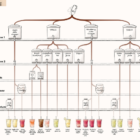For nearly a week, a giant container ship stranded in the Suez Canal blocked one of the busiest trade routes in the world. The Ever Given, a Rotterdam-bound vessel, was finally freed from the shoreline on Monday, and international media have closely followed the story and the consequences of the blockage. Our NodeXL #ddj mapping from March 22 to 28, which tracks the most popular data journalism stories on Twitter, found a visual story by the Reuters Graphics team that illustrated how the incident affected global trade. In this edition, we also feature an examination of bias in the beauty industry by The Pudding, a look into how the pandemic changed society by Al Jazeera, and a guide to drawing data visualizations by DataJournalism.com.









